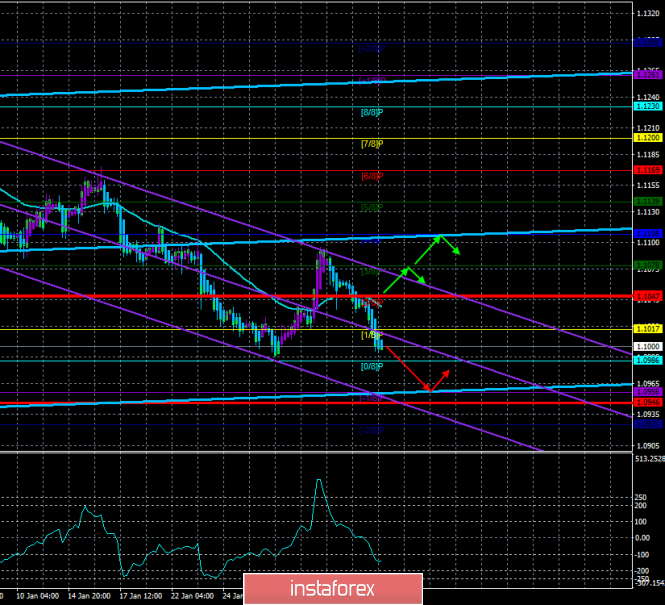4-hour timeframe

Technical details:
Higher linear regression channel: direction - upward.
Lower linear regression channel: direction - downward.
Moving average (20; smoothed) - down.
CCI: -146.5096
The third trading day of the week for the EUR/USD pair ended with the resumption of the downward movement. The macroeconomic background of the environment contributed to this development since the data from the European Union was not impressive and the data from overseas was very strong. Thus, it is quite logical that the euro/dollar pair resumed its downward movement, although it may again roll back from the area of lows and start moving up again. The fact is that describing the "paradoxical situation", we regularly say that the bears are simply afraid to continue selling the euro currency at levels below the mark of $1.10. However, in addition to the simple fear of trading lower, regular rebounds from this area can also be associated with pending purchase orders placed in this area. Thus, on Thursday, February 6, we can already witness the growth of the euro currency, even if there are no fundamental and macroeconomic reasons for this. However, we still recommend that traders do not try to guess the pair's reversal upward, but wait for the Heiken Ashi indicator to reverse, which will indicate at least an upward correction against the current downward trend.
In yesterday's morning review, we said that Christine Lagarde's speech, scheduled for Wednesday, will most likely not bring any new information to traders. And so it happened. The speech of the ECB head was not related to the monetary policy of the European Union or structural changes in the Central Bank, but, as we assumed, with the "coronavirus". According to the head of the ECB, the spread of the "coronavirus" on the planet brings a new portion of uncertainty to the world economy. Christine Lagarde said: "The threat of a trade war between the United States and China appears to have diminished, but the coronavirus adds to the uncertainty." Thus, according to Lagarde, the situation with the epidemic in China partially negates the positive effects of the signing of a trade deal between Beijing and Washington. According to the latest information, the Chinese authorities have suspended the operation of many factories in China, a huge number of firms and companies around the world have limited business trips to China to a minimum. Part of the staff was transferred to remote work. China's oil consumption has already decreased by 20% since the virus outbreak, air travel has decreased, and China's stock exchanges are experiencing serious problems and collapsing day by day. In fact, this means a slowdown in the Chinese economy. Is it worth recalling that the Chinese economy is closely tied to the economies of almost all countries of the world and its slowdown will mean a slowdown in the global economy, which will mean a recession in each particular economy, in particular, the European one?
At the same time, economic experts warn that the "coronavirus" outbreak could potentially be more dangerous than the crisis of 2008-2009. According to economists, the decline in mortgage lending was predicted, and no one could warn about the unexpected onset of a new virus pandemic in advance. Therefore, the authorities of China and other countries were not ready for such a test. "In contrast to the financial crisis, governments responsible for health and the economy may be limited in their means and capabilities to eliminate or compensate for losses from the pandemic," analysts said. Recall that according to various data, the official number of infected is now several tens of thousands, but representatives of the medical sector believe that the real numbers may be much higher.
No important macroeconomic publications are scheduled for Thursday, February 6, either in the European Union or in the United States. Just one more speech by ECB President Christine Lagarde, the essence of which may again be the increased risks to the world economy due to the new virus. If Christine Lagarde does not touch the subject of ECB monetary policy again, it will be very difficult to expect a reaction from traders. Since the macroeconomic background will be zero tomorrow, the euro may start to adjust after today's fall.

The average volatility of the euro/dollar currency pair has increased again and is now 51 points per day. Thus, on Thursday, we expect movement between the borders of the volatility range of 1.0946-1.1048. Most likely, a correction will begin, which can be determined by the reversal of the Heiken Ashi indicator to the top.
Nearest support levels:
S1 - 1.0986
S2 - 1.0956
S3 - 1.0925
Nearest resistance levels:
R1 - 1.1017
R2 - 1.1047
R3 - 1.1078
Trading recommendations:
The euro/dollar pair continues to move down. Thus, sales of the euro currency with the targets of 1.0956 and 1.0946 remain relevant now, until the Heiken Ashi indicator turns up. It is recommended to return to buying the EUR/USD pair not before the price is fixed back above the moving average line, which will change the current trend to an upward one, with the first targets of 1.1078 and 1.1108.
In addition to the technical picture, you should also take into account the fundamental data and the time of their release.
Explanation of the illustrations:
The highest linear regression channel is the blue unidirectional lines.
The highest linear regression channel is the blue unidirectional lines.
CCI - blue line in the indicator window.
Moving average (20; smoothed) - blue line on the price chart.
Murray levels - multi-colored horizontal stripes.
Heiken Ashi is an indicator that colors bars in blue or purple.
Possible price movements:
Red and green arrows.
The material has been provided by InstaForex Company - www.instaforex.com